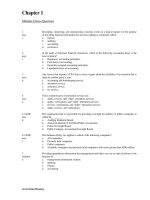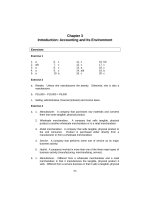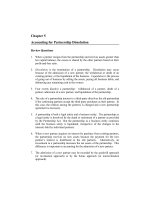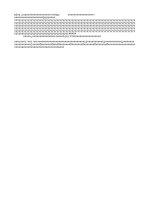Solution manual fundamentals of accounting by cabrera chapter 09 SM
Bạn đang xem bản rút gọn của tài liệu. Xem và tải ngay bản đầy đủ của tài liệu tại đây (179.35 KB, 10 trang )
Chapter 9
Reserves: Retained Earnings
Review Questions
1. The character of preference shares can be altered by being cumulative or
noncumulative, participating or nonparticipating, convertible or
nonconvertible, and/or callable or noncallable.
2. The dividend policy of a company is influenced by (1) the availability of
cash, (2) the stability of earnings, (3) current earnings, (4) prospective
earnings, (5) the existence or absence of contractual restrictions on working
capital or retained earnings, and (6) a retained earnings balance.
4. In declaring a dividend, the board of directors must consider the condition of
the corporation such that a dividend is (1) legally permissible and (2)
economically sound.
In general, directors should give consideration to the following factors in
determining the legality of a dividend declaration:
1. Retained earnings, unless legally encumbered in some manner, is usually
the correct basis for dividend distribution.
2. Revaluation capital is seldom the correct basis for dividends (except
possibly share dividends).
3. Additional paid-in capital may be used for dividends, although such
dividends may be limited to preference shares.
4. Deficits in retained earnings and debits in paid-in capital accounts must
be restored before payment of any dividends.
5. Dividends may not reduce retained earnings below the cost of treasury
shares held.
In order that dividends be economically sound, the board of directors should
consider: (1) the availability (liquidity) of assets for distribution; (2)
agreements with creditors; (3) the effect of a dividend on investor
perceptions (e.g. maintaining an expected “pay-out ratio”); and (4) the size of
the dividend with respect to the possibility of paying dividends in future bad
years. In addition, the ability to expand or replace existing facilities should
be considered.
2 Chapter 9
5. Dividends, at least cash dividends, are paid out of working capital. A balance
must exist in retained earnings to permit a legal distribution of profits, but
having a balance in retained earnings does not ensure the ability to pay a
dividend if the cash situation does not permit it.
6. A cash dividend is a distribution in cash while a property dividend is a
distribution in assets other than cash. Dividends payable in assets of the
corporation other than cash are called property dividends. Any dividend not
based on retained earnings is a liquidating dividend. A share dividend is the
issuance of additional shares of the corporation in a nonreciprocal exchange
involving existing shareholders with no change in the par or stated value.
7. A share dividend results in the transfer from retained earnings to paid-in
capital of an amount equal to the market value of each share (if the dividend
is less than 20-25%) or the par value of each share (if the dividend is greater
than 20-25%). No formal journal entries are required for a share split, but a
notation in the ledger accounts would be appropriate to show that the par
value of the shares has changed.
8. Retained earnings are restricted because of legal or contractual restrictions,
or the necessity to protect the working capital position.
9. Restrictions are best disclosed in a note to the financial statements. This
allows a more complete explanation of the restriction.
Exercises
Exercise 1
Aug.
1
Aug.
15
Sept. 9
Retained Earnings.......................................................................................................
3,000,000
Dividends Payable.........................................................................................
3,000,000
No entry.
Dividends Payable......................................................................................................
3,000,000
Cash...............................................................................................................
3,000,000
Reserves: Retained Earnings
3
Exercise 2
Sept. 21
Available-for-Sale Securities......................................................................................
525,000
Gain on Appreciation of
Securities....................................................................................................
525,000
Retained Earnings.......................................................................................................
1,400,000
Property Dividends Payable..........................................................................
1,400,000
Oct. 8
No entry.
Oct. 23
Property Dividends Payable.......................................................................................
1,400,000
Available-for-Sale Securities........................................................................
1,400,000
Exercise 3
Declaration Date.
Retained Earnings.......................................................................................................
650,000
Ordinary Share Dividend Distributable........................................................
100,000
Paid-in Capital in Excess of Par....................................................................
550,000
(10,000 X P65 = P650,000;
(10,000 X P10 = P100,000)
Distribution Date.
Ordinary Share Dividend Distributable.....................................................................
100,000
Ordinary Shares.............................................................................................
100,000
4 Chapter 9
Exercise 4
Item
Assets
Liabilitie
s
Equity
Paid-in
Capital
Retained
Earnings
Net
Income
1.
I
NE
I
NE
I
I
2.
NE
I
D
NE
D
NE
3.
NE
NE
NE
NE
NE
NE
4.
NE
NE
NE
NE
NE
NE
5.
D
NE
D
NE
D
D
6.
D
D
NE
NE
NE
NE
7.
NE
I
D
NE
D
D
8.
NE
NE
NE
I
D
NE
9.
NE
NE
NE
NE
NE
NE
Exercise 5
(a)
6/1
Retained Earnings
Dividends Payable
6/14
No entry on date of record.
6/30
Dividends Payable
Cash
8,000,000
8,000,000
8,000,000
8,000,000
(b)
If this were a liquidating dividend, the debit entry on the date of
declaration would be to Paid-in Capital rather than Retained Earnings.
(c)
One may observe that paying a dividend to the corporation is rather
circular. It does raise some potential for misdirection. However, this scenario
would simplify the routine cash disbursement to the registrar which acts as
the dividend disbursing agent. The dividend is not income, rather it is a
correction.
Cash.............................................................................................................................
240,000
Retained Earnings
240,000
Reserves: Retained Earnings
5
Exercise 6
(a)
(b)
Retained Earnings (15,000 X P37)
Ordinary Share Dividend
Distributable
Paid-in Capital in Excess of Par
555,000
Ordinary Share Dividend Distributable
Ordinary Share Capital
150,000
150,000
405,000
150,000
Retained Earnings (300,000 X P10)
Ordinary Share Dividend
Distributable
3,000,000
Ordinary Share Dividend Distributable
Ordinary Share Capital
3,000,000
(c)
3,000,000
3,000,000
No entry, the par becomes P5.00 and the number of shares outstanding
increases to 600,000.
Exercise 7
Total income since corporation
Less: Total cash dividends paid
Total value of share dividends
Current balance of retained earnings
P317,000
P60,000
30,000
90,000
227,000
Exercise 8
Event
a
b
c
d
e
Current
Assets
I
NE
NE
D
NE
Equity
I
I
NE
D
I
Net
Income
NE
NE
NE
NE
NE
Net Cash Flow
(from Any
Source)
I
NE
NE
D
NE
6 Chapter 9
Exercise 9
1. The error would be reported as an adjustment to the beginning Retained
Earnings balance in the 2008 statement of retained earnings or statement of
changes in equity.
2. Retained earnings, January 1, 2008............................. P 86,500
Adjustment for depreciation error in 2007..................
(36,000)
Retained earnings, adjusted, January 1, 2008............. P 50,500
Net income...................................................................
106,000
Dividends.....................................................................
(30,000)
Retained earnings, December 31, 2008................ P 126,500
Exercise 10
(1) Calculation of number of shares outstanding:
Jan.
Feb.
May
1
1
12
June
15
800,000 shares
550,000 shares
100,000 shares (1,000 100)
950,000 shares
104,500 shares (950,000 0.11)
1,054,500 shares outstanding
Amount to be paid in dividends for the third quarter,
1,054,500 P1.50 = P1,581,750
(2) Total dividends for 2007:
Mar.
June, Sept., and Dec.
=
=
P1.50 850,000 =
3 P1,581,750 =
P1,275,000
4,745,250
P6,020,250
Exercise 11
1. Retained Earnings ..............................................................
Share Dividends Distributable.....................................
Declaration of 25% share dividend; transfer
at stated value.
20,000
20,000
Share Dividends Distributable............................................
Ordinary Shares, P1 stated value.................................
20,000
20,000
Reserves: Retained Earnings
7
Issuance of share dividend.
2. The issuance of the share dividend had no effect on
each shareholder in the corporation. For each
representing an equity of P19.375 (P1,550,000
shareholder now holds 1¼ shares, representing an
(P1,550,000 ÷ 100,000 shares), or P19.375.
the ownership equity of
share previously held
÷ 80,000 shares), the
equity of 1¼ P15.50
3. Retained Earnings............................................................... 120,000
Share Dividends Distributable.....................................
Paid-In Capital in Excess of Stated Value...................
Declaration of 15% share dividend; transfer at
market value.
Share Dividends Distributable............................................
Ordinary Shares, P1 stated value.................................
Issuance of share dividend.
Test Material
Test Material 9-1
12,000
108,000
12,000
12,000
8 Chapter 9
P 736,000
a. Total dividends paid in third year.....................................................................................
Dividends on 9% cumulative preference shares:
P 360,000
Dividends (P50 .09 40,000 2 years)...............................................
180,000
Current year’s dividend (P50 .09 40,000).........................................
Total paid on 9% cumulative preference shares..................................
P 540,000
Dividends on 12% noncumulative preference
shares:
96,000
636,000
Current year’s dividend (P100 .12 8,000).........................................
Dividends on ordinary shares in third year.......................................................................
P 100,000
b. Dividends per share:
P 13.50 per share
Preference shares, 9% cumulative (P540,000 40,000 shares).......................
P 12.00 per share
Preference shares, 12% noncumulative (P96,000 8,000
shares)............................................................................................................
P 0.25 per share
Ordinary shares (P100,000 400,000 shares).................................................
c. The equity section of the balance sheet reports no additional paid-in capital. Thus, the
preference shares must have been issued at their respective par values (P50 per share for
the 9% cumulative preference shares, and P100 per share for the noncumulative
preference shares).
Reserves: Retained Earnings
9
Test Material 9-2
JFC Corporation
EQUITY
December 31, 2008
Paid-in Capital:
Preference shares, P100 par value
10,000 shares authorized, 4,000 shares
issued & outstanding
Ordinary shares, P50 par value
15,000 shares authorized,
8,000 shares issued 7,700 shares
outstanding
Additional Paid-in Capital:
Paid-in capital in excess of par—
Preference
Paid-in capital in excess of par—
ordinary
Paid-in capital from treasury shares—
Preference
Total Paid-in Capital
Retained Earnings:
Less cost of treasury shares
(300 shares—ordinary)
Total Equity
*P610,000 – P312,600 – P62,000
P400,000
400,000
P 800,000
52,000
61,000
4,700
117,700
917,700
235,400*
1,153,100
19,800
P1,133,300
10 Chapter 9









